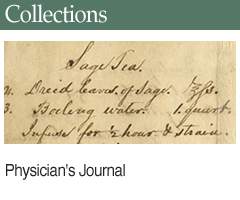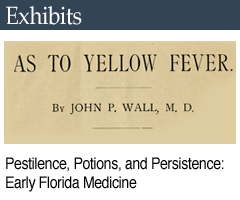Florida Mortality Schedules, 1850-1880
About these documents
Mortality schedules are lists of individuals who died in the 12 months preceding the federal censuses of 1850, 1860, 1870 and 1880. The schedules are organized by year and then by county. For each deceased person listed, the documents generally provide the person's name, sex, race, age at death, marital status, place of birth, occupation, cause of death and length of illness. The mortality schedules for 1850 and 1860 also track whether a person was enslaved or free.
These records are valuable for genealogists because the majority of the deaths they describe are not documented in any other source. Death certificates as we know them today were almost non-existent in Florida in the mid-19th century, and only a handful of public and private cemeteries maintained systematic lists of burials. Moreover, many of the individuals listed in these records were buried without permanent grave markers, or the markers were lost or destroyed over time. For these reasons, mortality schedules sometimes offer the only available information about an ancestor's death.
Another useful feature of the mortality schedules is their inclusion of African American slaves in 1850 and 1860. Population schedules, the part of the federal census used most widely for tracing family history, do not generally include the names of enslaved individuals. Despite their title, the slave schedules included in the federal censuses of 1850 and 1860 are not much help either because they often only list the age and sex of enslaved individuals, not their names. Mortality schedules generally list the given names and ages of African American slaves, and sometimes the names of their owners, all of which is vital information for tracing the lives of enslaved ancestors.
Mortality schedules do have a few key limitations. They only cover the 12 months leading up to each federal census, so ancestors who did not die during those brief windows of time are not included. As with any census record, there are also numerous misspellings and imprecise entries that use initials instead of complete names. Some individuals who should have been included are missing entirely, either because of a copying error or because a physician or family member failed to accurately describe the person's death. Researchers should bear these potential pitfalls in mind when using these records.
Using the collection
Given the potential for misspelled names and omissions, the best strategy is to start out with a broad search. If you are looking for a specific ancestor, try using the search bar to look for that person's surname within the county where you expect they would have lived at the time of their death. You may include given names in your search, but keep in mind that first and middle names are the most likely to be misspelled by the census taker, or to be replaced with initials.
If you limit your search to just a surname in a single county and are still having trouble, try searching in the mortality schedules for neighboring counties. You may also want to browse the schedules for the county where the family in question lived rather than searching by surname. Sometimes the spelling of a family name may have shifted by a letter or two over time, and that might account for your difficulties (e.g., Stevenson, Stevensen, Stephenson).
Browse Mortality Schedules
Keep in mind that county boundaries have shifted over time, so ancestors may be listed in a different county here than in other records.
- Alachua: 1850 | 1860 | 1870 | 1880
- Baker: 1870 | 1880
- Benton: 1850
- Bradford: 1870 | 1880
- Brevard: 1860 | 1870 | 1880
- Calhoun: 1850 | 1860 | 1870 | 1880
- Clay: 1860 | 1870 | 1880
- Columbia: 1850 | 1860 | 1870 | 1880
- Dade: 1850 | 1880
- Duval: 1850 | 1860 | 1870 | 1880
- Escambia: 1850 | 1860 | 1870 | 1880
- Franklin: 1850 | 1860 | 1870 | 1880
- Gadsden: 1850 | 1860 | 1870 | 1880
- Hamilton: 1850 | 1860 | 1870 | 1880
- Hernando: 1870 | 1880
- Hillsborough: 1850 | 1860 | 1870 | 1880
- Holmes: 1850 | 1860 | 1870 | 1880
- Jackson: 1850 | 1860 | 1870 | 1880
- Jefferson: 1850 | 1860 | 1870 | 1880
- Lafayette: 1860 | 1870 | 1880
- Leon: 1850 | 1860 | 1870 | 1880
- Levy: 1850 | 1860 | 1870 | 1880
- Liberty: 1860 | 1870 | 1880
- Madison: 1850 | 1860 | 1870 | 1880
- Manatee: 1860 | 1870 | 1880
- Marion: 1850 | 1860 | 1870 | 1880
- Monroe: 1850 | 1860 | 1870 | 1880
- Nassau: 1850 | 1860 | 1870 | 1880
- New River: 1860
- Orange: 1850 | 1860 | 1870 | 1880
- Polk: 1870 | 1880
- Putnam: 1850 | 1860 | 1870 | 1880
- Saint Johns: 1850 | 1860 | 1870 | 1880
- Saint Lucie: 1850
- Santa Rosa: 1850 | 1860 | 1870 | 1880
- Sumter: 1860 | 1870 | 1880
- Suwannee: 1860 | 1870 | 1880
- Taylor: 1860 | 1870 | 1880
- Volusia: 1860 | 1870 | 1880
- Wakulla: 1850 | 1860 | 1870 | 1880
- Walton: 1850 | 1860 | 1870 | 1880
- Washington: 1850 | 1860 | 1870 | 1880

 Listen: The World Program
Listen: The World Program


